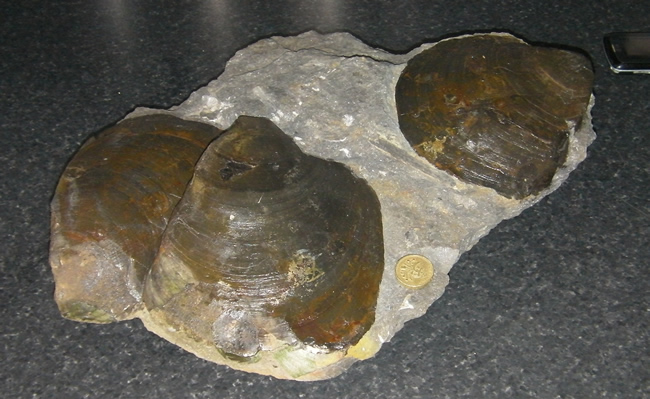The tiny sea front village of Waterloo is a good place to start for a short and easy fossil hunting location on Skye. This is a great place for a family fossil hunt and, for the beginner. Lower Jurassic fossils can be found in patches across most of the easily accessible bedrock.
DIRECTIONS
♦ Take the A87 for Broadford.
♦ Before you reach Broadford, turn left just after Scullamus and take the small single track road for Waterloo and Breakish. You will find a gate and path to take you to the beach.
♦ Ref: 57.23959°N, 5.87803°W
PROFILE INFO
FIND FREQUENCY: ♦♦♦ – Waterloo and Breakish are best visited at mid to low tide. Fossils can be numerous, with various horizons exposed at places. Loose rocks and broken bedrock can easily be split. However, ammonites are much harder to remove, as they are often found in hard baked sediment.
CHILDREN: ♦♦♦♦ – This is an excellent place for the family, offering stunning views, wildlife and fossils. Broadford is nearby for provisions. Overall, it is a good, child-friendly location.
ACCESS: ♦♦♦ – There are a few tiny lay-bys on the road near Waterloo on which to park. Just ensure you do not block any entrances. This is a shortest walk for any Skye location.
TYPE: – Fossils can be found in broken slabs of bedrock and in loose rocks. The bedrock often overlies softer lenses of clay shale, and these huge weathered slabs contain ammonites and worn corals from the Ob Lusa Coral Bed. Loose slabs can be opened up with the mallet and often huge bivalves are exposed.
FOSSIL HUNTING
This is an SSSI. There are no restrictions on visiting this location, but you must not hammer the bedrock or cliffs.Waterloo and Breakish have a good array of fossils for a small area. Although there are small ammonites in tiny pockets, they are very hard to remove from the baked bedrock. However, there are huge Psuedopecten and other bivalves to be found. Loose Gryphaea arcuata, which have been washed out from the thick beds made up of Gryphaea shells, are also exposed at various places.

The bedrock often overlies softer lenses of clay shale and these huge weathered slabs contain ammonites and worn corals from the Ob Lusa Coral Bed. Loose slabs can be opened up with the mallet and often huge bivalves are exposed. Do not hack into the main bedrock – it is neither necessary, nor allowed.
GEOLOGY
The rocks here are Jurassic in age, being about 192myrs old. The rocks at Breakish are from the Pleinsbachian Stage of the Lower Jurassic. The clay shale and harder limestones are visible over most of the foreshore. The clay shale is part of the Pabay Shale Formation from the LIas Group and correspond to the Ob Lusa Coral Bed.

SAFETY
There is good all round visibility to help see incoming tides. In addition, there is no need to wander too low into the slippery weed-covered rock territory.
EQUIPMENT
Wellies are best and an 8kg mallet, cold chisel and safety goggles can be useful. Mobile phone reception is usually good.
ACCESS RIGHTS
 Skye has a rich fossil heritage with particularly important fossils of Jurassic age. In addition to being Sites of Special Scientific Interest (SSSI) some areas of Skye’s coastline have added protection under a Nature Conservation Order (NCO). This Order seeks to protect vertebrate fossils that include the remains of dinosaurs. This guidance outlines how fossil collectors, visitors to the island and the general public have an important role in helping to look after these important fossils.
Skye has a rich fossil heritage with particularly important fossils of Jurassic age. In addition to being Sites of Special Scientific Interest (SSSI) some areas of Skye’s coastline have added protection under a Nature Conservation Order (NCO). This Order seeks to protect vertebrate fossils that include the remains of dinosaurs. This guidance outlines how fossil collectors, visitors to the island and the general public have an important role in helping to look after these important fossils.
 Scotland’s fossil resource is at risk of abuse and damage, and so we must all safeguard and managed fossil collecting to ensure its survival for future generations. For this reason it is VITAL you read and adhere to the Scottish Fossil Code for ALL sites in Scotland.
Scotland’s fossil resource is at risk of abuse and damage, and so we must all safeguard and managed fossil collecting to ensure its survival for future generations. For this reason it is VITAL you read and adhere to the Scottish Fossil Code for ALL sites in Scotland.
It is important to follow our ‘Code of Conduct’ when collecting fossils or visiting any site. Please also read our ‘Terms and Conditions‘
LINKS
♦ Buy Fossils, Crystals, Tools
♦ Location Discussions
♦ Deposits Magazine
♦ Join Fossil Hunts
♦ UK Fossils Network

















